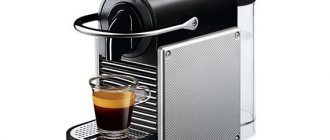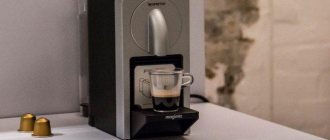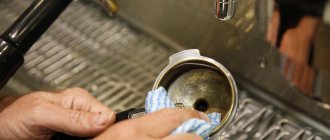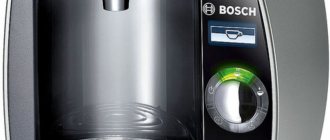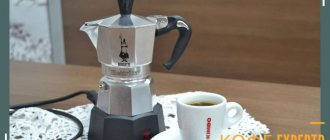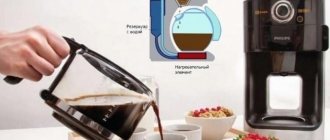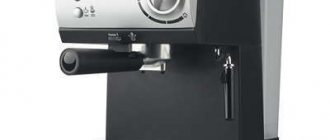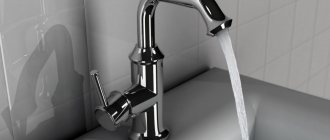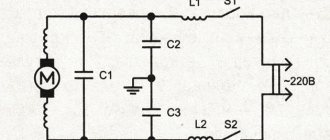Capsule coffee machines are becoming increasingly popular, as they differ from conventional ones in their ease of use: just insert the capsule and the drink is prepared. Capsules are purchased separately and are sold in coffee shops and large supermarkets. The price for a package of branded capsules is relatively low, but questions often arise about how long a capsule lasts for a coffee machine, and is it profitable?
Is it possible to put coffee back into the capsule?
The capsule contains regular ground coffee, and therefore the question often arises: is it possible to somehow pour regular coffee into it and will the drink be prepared? This cannot be done with regular standard capsules. But some manufacturers produce special reusable capsules into which you can pour a portion of ground beans, carefully remove the excess, close the lid and put it back into the coffee machine.
One reusable capsule can be used more than 50 times, then the membrane begins to deteriorate.
Reusable capsules for coffee machines are produced by Nespresso, Lavazza, Tassimo, Dolce Gusto, and some less famous manufacturers. Therefore, if you are just choosing a coffee machine and plan to save on capsules, you should choose one of these options.
Another important advantage of reusable capsules is the ability to add any coffee you like. Manufacturers usually offer a fairly limited selection of drinks, and sometimes you want something special, for example, special varieties or flavors. You can put whatever you want into a reusable capsule, add spices to your coffee or grind exclusive beans. Overall, it's tasty and convenient.
A little about the general or what affects the quality of extraction
In practice, we should highlight a couple of main functions that relate directly to the preparation of coffee drinks. To get an idea of how a machine brews coffee, you need to understand what extraction is.
Without getting into terminology, I will say that extraction is the extraction of useful substances from a dry mixture/solution . In the case of coffee machines, coffee powder releases caffeine and about four dozen coffee oils. This process completely depends on the equipment settings.
Settings can be divided into basic and auxiliary. The basic ones are present in all super-automatic machines. These are temperature, extraction time, amount of water used. Auxiliary – allow you to add additional parameters.
Key steps when setting up coffee machines:
- first, a complete control cleaning of the milk and coffee tract is carried out using special products;
- control measurements are carried out, which will identify possible settings errors;
- calibration is implemented;
- the correct settings are set;
- control.
How can you save on coffee capsules?
Single-use capsules are quite expensive, and therefore a prepared shot of espresso can be comparable in price to the cost of a drink in a coffee shop. The capsule is used once, for one cup, and it is much more expensive than buying ground coffee in packages or by weight. Of course, for those who care about taste, price is usually not an issue, but still.
- Disposable coffee containers cost about 25-36 rubles per piece (the price varies depending on the contents, the specific brand, and what packages and volumes to take, individually or in bulk.
- Reusable models are usually sold in packs of 2-4-6 pieces, and cost about 1000 - 2500 rubles per pack, although you can find various promotions and lucrative offers online. One capsule in this case costs about 400-500 rubles (you can find options for 200), but it will be enough for 50+ cups of coffee, and it turns out that the price of one preparation is 8-10 rubles. Plus the price of coffee, of course. But in any case, it turns out cheaper, and at the same time you drink your favorite drink.
How to prepare different types of coffee? Amount of coffee.
Share what's interesting! ;)
Any barista knows that the basis of every type of coffee (be it cappuccino, Americano or latte) is espresso. To make espresso, you need to pour hot water into the coffee machine and pass it through a filter with freshly ground coffee. In this case, the pressure in the device should be from 9 to 11 bar (the optimal option is 15), and the water temperature should be 90-95 ℃. Thanks to this technology, the coffee will become as concentrated and thick as possible.
To prepare one serving of espresso, you need from 25 to 35 ml of water and approximately 10 g of freshly ground coffee beans. You can make several other equally popular types of espresso-based coffee. For example, lungo will require less coffee, but the volume of water will be the same. As for doppio, in this case you need to take a little more coffee per serving than usual.
Americano is the same as espresso, but it is diluted with water to make it less concentrated. This is an Italian version of the drink that appeared in Europe during World War II. The standard serving of the drink is 120 ml, and the volume of the cup when served can be up to 180 ml.
There are two popular recipes for making Americano:
- Italian. First, prepare espresso, then add water to it (ratio 1 to 3). The crema typical of espresso disappears during preparation, resulting in a classic North American drink.
- Swedish. In this case, the barista’s task is to preserve the foam in its original form. For this purpose, a freshly brewed portion of espresso is carefully and gradually added to boiling water. The foam becomes uniform and has a pleasant light shade. The ratio of water and coffee is the same - 1 to 3.
Making cappuccino is a little more complicated. You need to take 200 ml of milk (it must be cold), coffee (10 g) and water (25 to 34 ml). Whisk the milk until thick foam forms. For this purpose, the barista uses a cappuccino machine. It is found in every professional coffee machine. If you don’t have a cappuccino maker, you can whip the milk until foamy using a blender or manually using a small whisk. After this, a portion of espresso is poured into the cup, and then milk with foam. The top layer of foam is laid out at the end of the cooking process. The temperature of the cappuccino served to the client should be 60-70 ℃.
For the latte you will also need milk (300 ml), coffee (10 g) and water (35 ml). Cold milk is frothed, then espresso is brewed and the milk, whipped until foamy, is poured into an Irish glass or other transparent container. The main thing is that the components do not mix with each other. After two minutes, the drink will begin to separate: the milk will go down, the coffee will be in the middle, and the light foam will be on top.
The barista can also add variety to his coffee assortment using syrups, toppings and other fruit additives.
By the way, I recommend taking coffee from this list.
What to consider when purchasing a capsule machine
Firstly, intuitive service. The device must be easy to use and intuitive. It is good to have at least two types of drink (espresso and lungo). Without this, you usually have to control the water supply.
It’s good that the device has a fairly large water container - more than 0.5 liters.
Secondly, the coffee maker must be durable enough. Plastic coverings love to crack, fall and are easily destroyed. This is a device we're going to use every morning, so it makes sense to go with the aluminum trim option rather than the plastic one.
Third, easy cleaning. The coffee machine should be easy to disassemble as it should be washed frequently. Therefore, before purchasing, you should pay attention to whether the containers can be easily removed and cleaned.
Fourthly, savings. Take a close look at the unit's wattage and heating times, as well as its automatic shut-off features—equipment must be energy efficient for economic and environmental reasons.
An important parameter is also the availability of capsules and their substitutes - in some models we associate only with one capsule manufacturer, and the choice of coffee is quite limited. It's good to have an alternative.
Fifthly, the amount of work. Not everyone, when brewing their first morning espresso, wants to wake up their entire family. Small rooms, offices and family kitchens appreciate quiet units.
Sixth, milk. For milk coffee lovers, one of the most important benefits is the milk frother or steamer. Most cheap models do not have the ability to froth milk.
Advantages and disadvantages
Coffee capsules have pros and cons. Their main advantages are:
- Preservation of taste and aroma after opening the package, unlike a ground or grain product.
- There is no need for careful pressing and measuring of the product, as is the case with carob coffee machines.
- Cost-effective, easy to use, compact and convenient devices.
- Possibility of preparing loose leaf tea (in many devices) . You just need to thoroughly rinse the device every time so that odors from different drinks do not mix in it.
- Availability of different tastes , the possibility of obtaining new products.
- Quick cooking. You just need to place the product inside the special compartment, place the cup on the tray, select the required recipe and press the start button.
- There is no need to use filters or constantly wash the device . The used pack is removed from the compartment and disposed of. Caring for the device consists of performing a number of simple procedures: pouring water, automatic rinsing, emptying the capsule container, and occasional washing using special products.
- The durability of the coffee machine, which allows you to use it for 10 years if you follow the instructions for use.
- Low noise level during preparation of a drink compared to standard coffee makers.
Coffee capsules also have some negative sides:
- High cost compared to regular coffee.
- Incompatibility with coffee makers produced by different manufacturers.
- Lack of product in mass sale, the need to pre-order it.
What are the best capsules for a coffee machine?
The fastest way to prepare it is coffee in capsules. They can suit a specific brand or be universal. After conducting a comparative analysis of the advantages and disadvantages of each nominee, Vyborexperta.ru recommends:
- Nespresso Volluto – high organoleptic properties of Swiss coffee;
- Starbucks House Blend – large portions, varying degrees of roasting;
- Nescafe Dolce Gusto Cappuccino – espresso with creamy notes for a large cup;
- Nescafe Dolce Gusto Espresso – high intensity, floral aftertaste;
- Tassimo Jacobs Americano Classico – classic Americano, pronounced aroma;
- Tassimo Baileys Latte Macchiato – espresso with cream liqueur, creamy foam.
The machine instructions indicate which containers can be used. For many, the choice of flavors, additives, strength and bitterness is individual. The rating showed which products are purchased more often than others and receive favorable reviews from gourmets. These are mainly original containers from Nespresso, Nescafe, Starbucks, Tassimo.
Temperature settings
I repeat that the basic settings should be set on a coffee machine where complete decalcification, cleaning of the coffee and milk tracts, and the dispensing unit have been carried out using special chemicals. Otherwise, contamination will disrupt the throughput of the systems, which will be poorly reflected in the settings . You can learn about the principles of removing scale and coffee fats in another material.
The second point is that coffee extraction depends on the flow time and water temperature. The optimal temperature is 86-96 degrees (we take into account the quality of the grain and our own taste). The temperature can be adjusted on any coffee machine using the appropriate menu button and using a digital display.
For each type of drink (espresso, cappuccino, latte, etc.) you can set:
- low;
- standard;
- high temperature.
This is an option for the simplest models. In professional equipment, the temperature is adjusted by degrees, both individually for each type of coffee and in general . As a rule, you need to operate manually, by adding cold water, opening/closing the valve. Turning the knob counterclockwise one notch lowers the temperature by 1 degree and vice versa.
If the coffee is not very hot
As noted, the temperature of the drink can be low, medium, or high. I advise you to check this point in the settings, increasing the parameter to the appropriate value if you like it hot. The second point is starting the device. Before preparing the first cup, I advise you to activate the rinse function, otherwise the drink will always be warm even at maximum settings. Most often, the strait option is listed as rinsing. This way the device will go from cold to working.
Additionally, I note that temperature greatly affects the taste of coffee. If you set it above 93 degrees, it will be bitter; if below 90 degrees, you will get under-extraction and a weak taste. For better results, the temperature must be maintained with an accuracy of 1 degree. I’ll say right away that this is not available in budget household machines. Here it is more appropriate to use a lightly roasted single-origin coffee, preferably without Robusta. Set the temperature a little higher, since by the end of the extraction the device will lose about 5 degrees.

